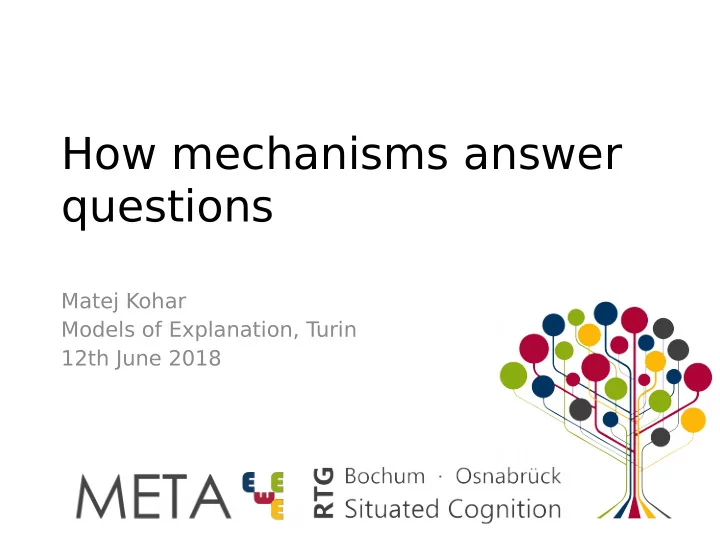

How mechanisms answer questions Matej Kohar Models of Explanation, T urin 12th June 2018
Problem ?? Why X? ?? Because Y. 2
Outline 1. Mechanistic explanation 2. Pragmatics of explanatory speech- acts 3. Wrong solutions 4. The solution 3
1. Mechanistic explanation “A mechanism is a structure performing a function in virtue of its component parts, component operations, and their organization. The orchestrated functioning of the mechanism is responsible for one or more phenomena.” (Bechtel and Abrahamsen 2005: 423) “In biology, identifying phenomena precedes and invites explaining them. … [T]he term biologists most frequently invoke in explanatory contexts is mechanism . … [B]iologists explain why by explaining how .” ( ibid .: 422) 4
1. Mechanistic explanation • Explanandum phenomenon • Explanans mechanism • Causal/constitutive relation • Entities and activities appropriately organised 5
2. Pragmatics of explanatory speech acts (van Fraassen 1977, 1980) • Explanatory requests: <A, X, R> – A: the topic (explanandum) – X: contrast class – R: relevance relation 6
2. Pragmatics of explanatory speech acts • Answer: “Because B.” – A is the case – Ɐx X: x → x = A – R(B, A) • Note: not good answer, just an answer • Evaluation criteria available, but R eliminates most bad answers • R determines which evaluation criteria to use 7
4. Solution • Basic idea: identify a set of changes to the mechanism for the phenomenon, which, had they been actual, would change it into a phenomenon that belongs to the contrast class • Afnity with mutual manipulability strategy for discovery – many explanations are found in top-down experiments 15
4. Solution • More precise characterisation needed • Slight diferences between explanation of token phenomena and explanation of regularities require separate treatment 16
4.1 T oken phenomena • Explanatory request: < f , G> f : a token phenomenon G: a contrast class of phenomena defned by membership conditions • f ∉ G • G can be empty • Why did f occur rather than some g ∊ G? 17
4.1 T oken phenomena • Answer: “Because C f rather than C G C f : a subset of components of mechanism M f for phenomenon f C G : a set of counterfactual mechanism components • If C f were replaced by C G in M f , the resulting mechanism would underlie a phenomenon g ∊ G 18
4.2 Regularities • Diferences: – Multiple question types – Mechanistic models, instead of mechanisms as such are involved in explanation • Explaining a regularity: answering an explanation request about multiple token phenomena 19
4.2 Regularities - questions • T ypes of explanatory request about regularities: – substantive – frequency – timing 20
4.2 Regularities - questions • Substantive explanatory request: <F, G> F: a class of explanandum phenomena defned by membership conditions G: a contrast class of phenomena defned by membership conditions • F ∩ G = ∅ • G can be empty 21
4.2 Regularities - questions • Frequency explanatory request: <F, φ, φ*> F: A class of explanandum phenomena defned by membership conditions φ: the frequency at which instances of F occur φ*: a contrast frequency φ* ≠ φ • φ* can be 0 22
4.2 Regularities - questions Timing explanatory request: <F, T, T*> F: a class of explanandum phenomena defned by membership conditions T: a set of time intervals during which instances of F occur T*: a contrast set of time intervals • T* ≠ T 23
4.2 Regularities - answers Substantive explanatory request: “Because C F rather than C G ” C F : a subset of components of M F – the mechanistic model for class F C G : a set of components such that any phenomenon underlain by a mechanism adequately represented by the mechanistic model M G = M F – C F + C G would be a member of class G. 24
4.2 Regularities - answers Frequency explanatory request: “Because set-up conditions for mechanisms adequately represented by M F , the mechanistic model of F, occur with frequency φ rather than φ*” • Can be supplemented by etiological mechanistic explanation of the set-up conditions • Can be treated as an instance of explaining token phenomena 25
4.2 Regularities - answers Timing explanatory request: “Because set-up and termination conditions for mechanisms adequately represented by M F , the mechanistic model of class F, specify intervals in T rather than intervals in T*” • Can be flled in by an account of how conditions in T* would have to change to trigger mechanisms adequately represented by M F , • or how M F would have to change in order for mechanisms adequately represented by it to be triggered in T* 26
4.2 Regularities – mechanistic models • See Glennan (2017) • Obtained from token mechanisms by abstraction • Properties of components specifed in a less determinate way, so that the description which specifes the mechanistic model is similar to actual members of the modelled class 27
Thanks for attention!
References Bechtel, W. & Abrahamsen, A. (2005). Explanation: a mechanist alternative. Studies in History and Philosophy of Biology and Biological Sciences 36 (2), 421-41. Glennan, S. (2017). The New Mechanical Philosophy . Oxford: Oxford University Press. Van Fraassen, B. (1977). Pragmatics of explanation. American Philosophical Quarterly 14 (2), 143-50 Van Fraassen, B. (1980). The Scientific Image . Oxford: Clarendon.
Recommend
More recommend